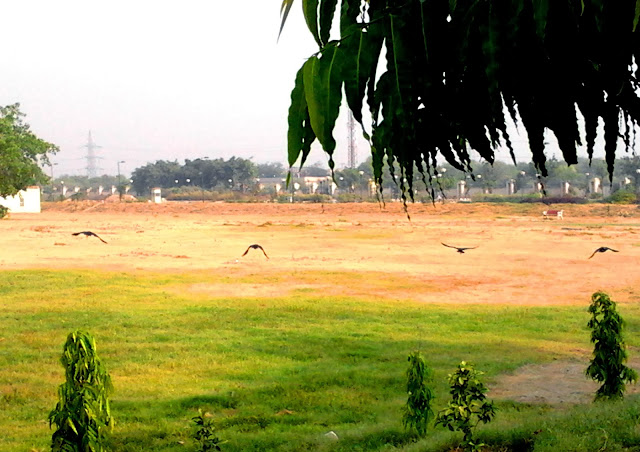Red naped Ibis or Black Ibis (Pseudibis papillosa Temminck) near Najafgarh drain forest cover, New Delhi, India.
 |
| Black Ibis Flock at GGSIP University Campus, Dwarka, Delhi |
During a bright glittery morning of March while morning walk around 5:00 am of 2013. I saw some large sized birds around my play
ground at GGSIPU campus, Dwarka, New Delhi. It was not an usual bird watch for me. I went to ground to see them and captured the presence of these birds on my camera. There is forest cover encircling the campus trailing one
of the longest sewage drains in Delhi “the Najagfarh drain” which passes along
the University. Forested embankments of Najafgarh drain are currently classified as and are featured in Protected Forests and RECORDED FORESTS (NOTIFIED FOREST AREAS IN DELHI). It has become a preferred destination for both migratory and
resident birds flocking. It is quite a close to nature place in Delhi. These birds were identified as Red headed ibis which were in a group for food trail
early in the morning. these are given Least Concern (LC) category was assigned in IUCN. As such they do not qualify as threatened, Near Threatened, or
(prior to 2001) Conservation Dependent.
 |
| Satellite imagery of the forest cover and Najafgarh drain near GGSIP University, Dwarka, Delhi |
The Indian red naped ibis or Black ibis is one of the 23 ibis species of the world, and one of 33 avian species belonging to the family Threskiornithidae. It is a medium sized bird of about 68 cm length
with a wing span of about 38 cm having a 16 to 19cm long tail. The adult bird
has a triangular patch of red warts on the head and extending about 13 to 17 cm
long down curved bill. It has an inner lesser wing covert with a white shoulder
patch that is visible while the bird is in flight. The neck, mantle, lower
back, rump and lower plumage are all brown. It was a fun to watch the birds
with scapulars and back bronze green feathers. The tail is black and richly
glazed with blue green. The wings are black, glazed blue and secondary feathers
of wing are sometimes flecked with white. A large, brood patch of white runs
along the leading edge of the wing on the lesser wing coverts to well below the
carpal joints. Although prominent in flight, this features shows only a thin
white line when the wings are closed. The short legs are hidden beneath the
steel blue tail in flight. The tibia has feathering half way to the tarsus
joint. The head, somewhat square shaped is black and distinctively capped with
a triangular patch of warty red skin, absent in juveniles. The eye is orange red to bright red.
 |
Pseudibis papillosa Temminck ; Photo source: Anonymous |
The curved bill and the broad stubby feet are horn coloured. Many migratory bird species that have huge ecological value for maintaining a functional aquatic eco-system and natural food chain come to the surrounding forest near Dwarka and adjacent area of this Najafgarh drain, New Delhi. The drain is a good habitat with adequate availability of food and shelter for migratory birds. The number is increasing every year. In an article of the Hindu dated 6, 2013 “75 bird species find a home around Delhi’s dirtiest drain” it was reported that among the endangered or threatened species, as many as 34 oriental white ibis or black-headed ibis, which are “near threatened”, showed up while the number of migratory painted stork rose sharply to touch 121. Migratory birds which had came to the marshlands alongside the drain included the northern shovelers (numbering 90) and northern pintails (10) that breed in North Asia and migrate in winter to East, South-East and South Asia. Then around 98 gadwalls, which breed in Central Asia and migrate in winter to East and South Asia, 16 common coot that are residents of India, Bangladesh, Pakistan and Myanmar and migrate in winter to East, South-East and South Asia, 31 common teals and 10 Eurasian wigeons that breed in North Asia and migrate in winter to East, South-East and South Asia, 13 woolly-necked storks which are residents of South-East Asia and migrate to South Asia, 37 black ibis and 18 glossy ibis which are residents and migrants in South Asia, have been spotted. It is reported that the ibis selected live and unbroken canopies of the tall trees to roost.
 |
| Flocks of Red naped Ibis or black Ibis form distinctive V-shaped flight patterns |
Update on Ibis Population (2019)
In past years population of Red naped Ibis was increased in the GGSIPU campus, Dwarka, New Delhi. The Ibis flock was 5 in number when I started this blog as an enthusiast/Bird lover in 2013. Now its year 2019 and the number of species raised upto 23 in number a flock visiting our lush green Campus. With tree canopy the bird population is also increased. Residents can feel great difference in increased bird species diversity and their bird chirping sound effects.
In past years population of Red naped Ibis was increased in the GGSIPU campus, Dwarka, New Delhi. The Ibis flock was 5 in number when I started this blog as an enthusiast/Bird lover in 2013. Now its year 2019 and the number of species raised upto 23 in number a flock visiting our lush green Campus. With tree canopy the bird population is also increased. Residents can feel great difference in increased bird species diversity and their bird chirping sound effects.
Reference



Comments
Post a Comment